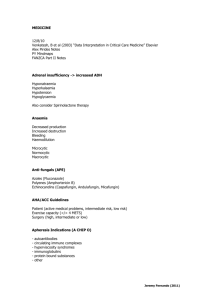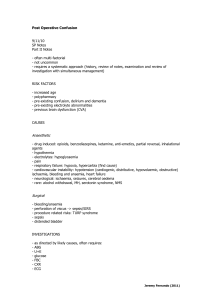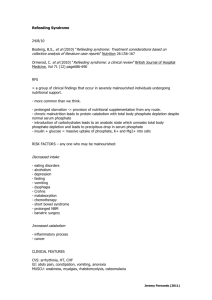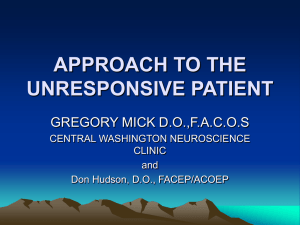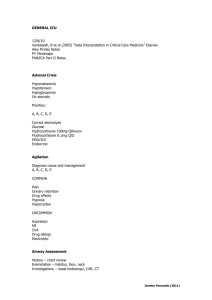SURGERY
advertisement
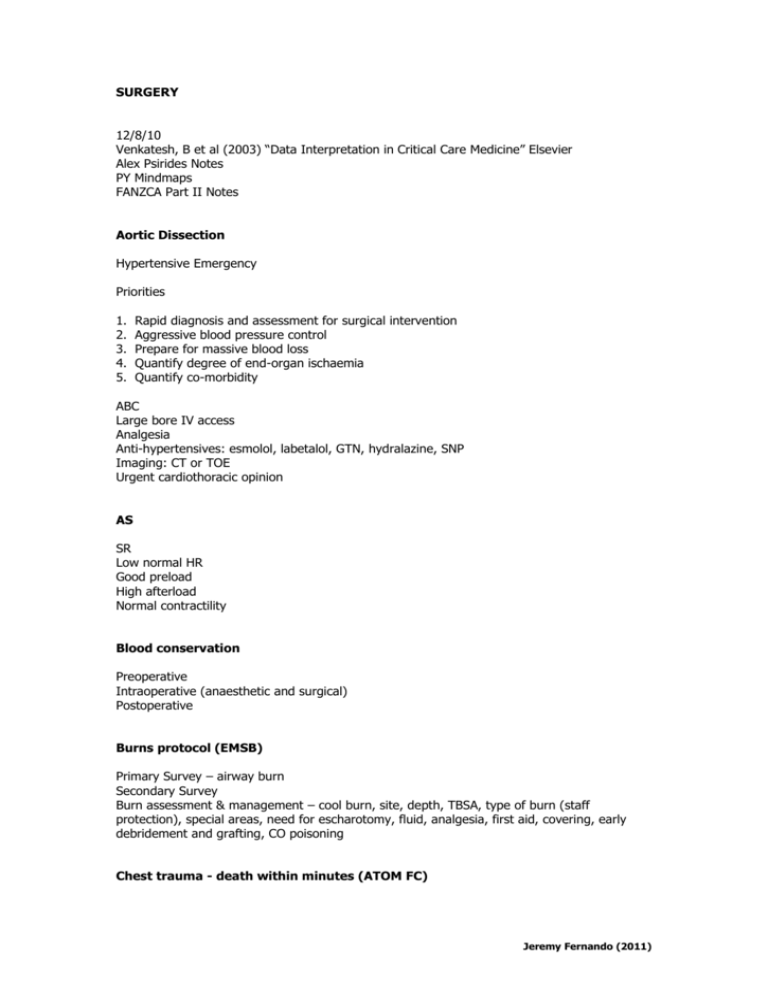
SURGERY 12/8/10 Venkatesh, B et al (2003) “Data Interpretation in Critical Care Medicine” Elsevier Alex Psirides Notes PY Mindmaps FANZCA Part II Notes Aortic Dissection Hypertensive Emergency Priorities 1. 2. 3. 4. 5. Rapid diagnosis and assessment for surgical intervention Aggressive blood pressure control Prepare for massive blood loss Quantify degree of end-organ ischaemia Quantify co-morbidity ABC Large bore IV access Analgesia Anti-hypertensives: esmolol, labetalol, GTN, hydralazine, SNP Imaging: CT or TOE Urgent cardiothoracic opinion AS SR Low normal HR Good preload High afterload Normal contractility Blood conservation Preoperative Intraoperative (anaesthetic and surgical) Postoperative Burns protocol (EMSB) Primary Survey – airway burn Secondary Survey Burn assessment & management – cool burn, site, depth, TBSA, type of burn (staff protection), special areas, need for escharotomy, fluid, analgesia, first aid, covering, early debridement and grafting, CO poisoning Chest trauma - death within minutes (ATOM FC) Jeremy Fernando (2011) Airway compromise Tension pneumothorax Open pneumothorax Massive haemothorax Flail chest Cardiac tamponade Chest trauma - death within hours-days (POTMAD) Pulmonary contusion Oesophageal injury Tracheo-bronchial injury Myocardial contusion Aortic injury Diaphragmatic injury Cervical Spine Assessment + Management Protect History – pain Examination – swelling, deformity, tenderness Investigations – 3 xray views + CT (high resolution, 1-2mm slices with sagittal reconstructions -> misses <1% of injuries) Classes of Hypovolaemic Shock I (<20%) to IV (>40%) P Systolic BP CR LOC Compartment Syndrome Surgical emergency -> urgent decompression Keep limb @ level of heart Release all bandages Pressure within 30mmHg of diastolic pressure = diagnosis Facicotomy IVF Stablise # Monitor for multi-organ failure Cerebral Perfusion Pressure CPP = change in pressure (MAP – ICP or CVP) CBF = CPP/resistance Cerebral Protection Aim = prevention of secondary injury Jeremy Fernando (2011) A, B, C, D, E approach Damage Control Surgery Open Pack Resect and stop bleeding in quadrants Cover Resuscitate Definitive care Determinates of Myocardial O2 Supply and Demand SUPPLY - arterial O2 content (Hb and SpO2) diastolic BP HR blood viscosity coronary vascular resistance LVEDP DEMAND - myocardial wall tension - HR Double Lumen Tube Indications “Lung isolation” 1. 2. 3. 4. Blood Pus Bronchopleural fistula Pulmonary carcinoma for large extraction Electrocution Turn off power ACLS protocol Trauma protocol Burn protocol Epidural Abscess Rapid assessment & diagnosis Definitive management within 8 hours Fractured NOF Anaesthesia Jeremy Fernando (2011) Priorities 1. 2. 3. 4. 5. Early operations Fluid resuscitation Diagnose reason for fall Assess and manage co-morbid conditions (polypharmarcy, falls, IHD, COPD) Liaise with loved ones Head injury Prevent secondary injury Optimise CPP Manage raised ICP Protect and assess c-spine Haemostatic Resuscitation Permissive hypotension Early RBC’s Early plasma & platelets Pro-coagulant therapy ICP management - optimise blood flow in and out of the brain - decrease the brains metabolic rate - osmotherapies L->R Shunt Aim: decrease shunt High PVR Low SVR Life Threatening Bleeding Sites (CRAFT) Chest Retroperitoneum (pelvis) Abdomen Floor Thighs bones Liver Failure CAUSES (DAVE): drugs, alcohol, viruses, extras (acute fatty liver of pregnancy, HELLP, eclampsia, toxins, vascular, metabolic, autoimmune) MSD CVS: hyperdynamic and vasodilated, cardiomyopathy Jeremy Fernando (2011) RESP: orthodeoxia, platypnoea GI: ascites, hepatosplenomegaly GU: hepatorenal syndrome HAEM: coagulopathy -> major blood loss CNS: encephalopathy, increased ICP ELECTROLYTES: hyponatraemia, hypokalaemia, elevated ammonia, hypophosphataema, hypoglycaemia Long Anaesthetic - invasive monitoring hypothermia cares pressure care IDC analgesia VTE prophylaxis post-operative ventilation Massive Transfusion in Trauma = replacement of patients entire blood volume within 24 hours OR >250mL/hr OR > 150mL/min IV Access and equipment Notify haematology, blood bank, ICU, surgery, radiology RBC 10U FFP 10U Plt 2U Cryo 2U Reverse anti-anticoagulants Anti-fibrinolytic agents Consider Damage Control Surgery or rFVIIa (100mcg/kg) Neck Trauma Priorites: 1. Secure airway 2. Protect C-spine Assess – history (AMPLE), examination (ob’s, neck), investigate (xrays, CT, endoscopy), management (GORD prophylaxis, prokinetics, O2) Options: Awake cricothyroidotomy/tracheostomy Awake direct laryngoscopy AFOI Inhalational induction Femoral-femoral bypass OLV and Hypoxia Jeremy Fernando (2011) Check O2 supply -> ETT Cardiac output V/Q mismatch FiO2 1.0 Suction CPAP to operative lung PEEP to dependent Intermittent reinflation Clamp bronchial artery if doing pneumonectomy Return to two lung ventilation Pancreatitis (I GET SMASHED) Idiopathic Gall stones Ethanol Triglycerides Steroids Mumps and other viruses (EBV, CMV) Autoimmune disease (SLE, polyarteritis nodosa) Snake or scorpion bites Hyper – calcaemia, lipidaemia, Hypothermia ERCP Drugs (SAND – sulphasalazine, azathioprine, NSAIDS, diuretics) OR Idiopathic Obstructive Parenchymal Polyuria in Traumatic Brain Injury Osmotic diuretic induced (mannitol) Diabetes insipidus Alcohol associated diuresis Cerebral salt wasting syndrome Hypertonic salt administration Appropriate response to fluid therapy Hypertensive diuresis Hyperglycaemia Prognostication in TBI Clinical Predictors - age (>55 is predictive of poor outcome) - initial GCS post-resuscitation - hypotension and hypoxia Jeremy Fernando (2011) - pupil size and reaction to light ICP nature & extend of the intracranial injuries (worst to least, subdural -> extradural -> SAH) co-morbidities Radiological Predictors - presence of cisterns midline shift lesions whether lesions evacuated brainstem injury - MRI @ 6-8 weeks: injuries to corpus callosum, corona radiate and dorsalateral brainstem -> higher incidence of PVS Plastic Surgery Difficult airway Long anaesthetics Poor access to patient Smooth emergence Analgesia (mild to moderate pain + LA use) High maintenance clients R->L Shunt Aim: optimise RV function and PVR Low PVR High SVR Renal protection 1. Careful fluid management 2. Avoid nephrotoxic agents 3. Ensure adequate emptying There are a number of other issues -> divide into pre, intra and post op Scoliosis Surgery Preop – assess patient, MSD, Intraop – monitoring neurologically, bleeding, long, no relaxant Postop – hyponatraemia, bleeding, neurological monitoring Sitting Position - long operation - airway access - airway swelling and trauma Jeremy Fernando (2011) - hypotension DVT cares VAE pressure cares Tourniquets Minimise time (max 2 hours) UL = systolic + 50mmHg LL = systolic x 2 Systemic CVS – increased SVR, increased circulating volume, increased HR and BP -> hypotension and vasodilation post deflation RESP – increased PvO2, increased MV CNS – increased CBF and ICP on release HAEM – increased platelet aggregation, hypercoagulable, increased tPa -> systemic thrombolysis post release, no increased in DVT METABOLISM – increased catecholamines, isolated limb -> hypothermia, increased K+, lactate, CO2 and O2 consumption Local Nerve injury Muscle injury Vascular injury Skin injury Trauma Intubation RSI with inline immobilisation If hypoxic bag Relax CP if affecting view 1. 2. 3. 4. 5. DL DL with boujie LMA or ILMA Optical stylet Surgical cricothyroidotomy Trauma protocol (EMST) Primary Survey – management of life threatening injuries + resuscitation Airway with C-spine control (open, adjuncts, ETT) Breathing with O2 (rule out life threatening chest injury) Circulation with control of external haemorrhage (2 x large IV access, trauma bloods, IVF) Disability with rapid neurological assessment (AVPU, pupils, glucose, limb movement) Exposure with hypothermia care (undress, log roll and keep warm) Investigations: - xrays (lateral c-spine, CXR and pelvis) Jeremy Fernando (2011) - cross match FBC U+E LFT’s amylase Secondary Survey - head to toe assessment + definitive treatment Transfusion Risks Haemolytic - ABO - Rh - Kell Duffy Allergic - TRALI transfusion reaction anaphylactoid anaphylaxis graft vs host disease purpura Infective - virus (HIV, Hep B and C) - bacterial - protozoan Other - citrate toxicity hyperkalaemia massive transfusion TACO Vasospasm management - prevention: removal of SAH at surgery, nimodipine, maintenance of euvolaemia, avoiding hypotension - monitoring: clinical, transcranial doppler, 4 vessel angio, CTA/MRI, EEG, SPECT/PET, microdialysis catheters - treatment: haemodynamic augmentation to reverse neurological deficits, endovascular treatment (balloon angioplasty, papaverine, nicardipine), investigational therapies Jeremy Fernando (2011)

